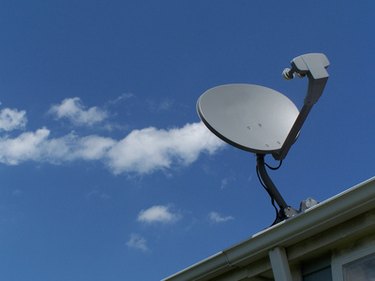
Degradation of picture quality is a common issue among cable and satellite providers alike. Satellite connections present unique challenges to ensuring consistent picture quality as they require a direct, uninterrupted connection between the satellite and your satellite receiver. Therefore, everything from sun spots and solar flares to heavy fog and overcast skies can degrade your picture quality. If you subscribe to DIRECTV or another satellite provider and experience poor picture quality, you can try troubleshooting the problem yourself to avoid calling the repair technician.
Step 1
Check connections. There should be at least one coaxial cable coming in from a wall outlet that is connected to your DIRECTV receiver. Check the connections on both sides of the cable, on the wall and on the receiver, and make sure they are not loose. Tighten them if necessary.
Video of the Day
Step 2
Reset the coaxial input. After verifying that the connections have not come loose, the next step is to remove and replace the cable to clear any dust or static electricity that built up on the connection. Completely unscrew the same coaxial cable as in Step 1 and detach it from the DIRECTV receiver. Check the copper needle that runs through the middle of the cable for any bending, chipping or damage. If the needle is bent slightly, you can carefully bend it back into place. Screw the cable back onto the receiver and check for any improvements in picture quality.
Step 3
Reset the DIRECTV receiver. If the picture quality still has not improved at this point, it is possible the DIRECTV receiver may just need a simple reboot. Locate the electrical cord that connects the receiver to an electrical outlet and detach it either from the electrical outlet or from the back of the receiver, whichever is easier for you to reach. Count 30 seconds and plug the cord back in. Check for improvements in picture quality when the receiver fully reboots.
Step 4
Check for inclement weather. Satellite TV requires a clear, uninterrupted connection between your receiver and a satellite. Therefore, any inclement weather like overcast skies, rain, snow or heavy fog can cause a degradation in picture quality. If none of these are occurring right now in your area, the only other option is to contact DIRECTV.
Step 5
Contact DIRECTV technical support. A representative can take you through some more advanced troubleshooting steps and can identify any service outages or degradations your neighborhood may be experiencing. The representative can also schedule a technician to come out and repair your system, if necessary
Video of the Day